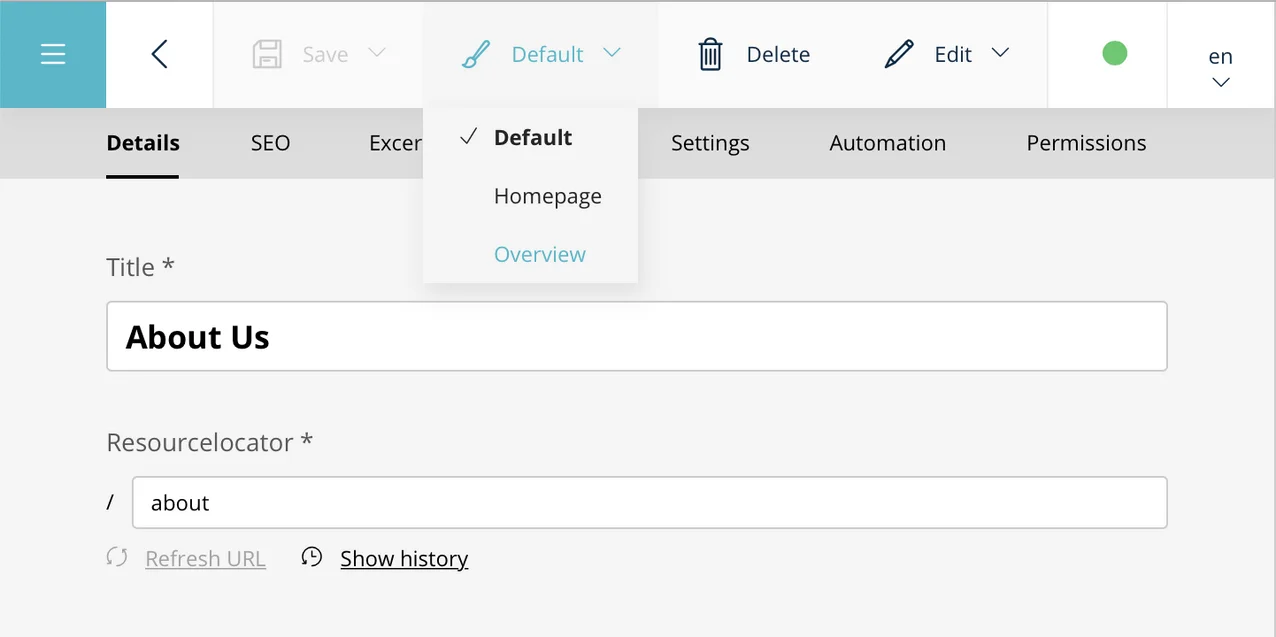How Enterprises Benefit from Sulu’s Rigorous Templating and Structured Content
We recently released our new guide on templating with Sulu, which shows how we cleanly separate content from presentation. In this article, we’re going to tell you why this has big benefits for enterprise websites and web applications.
What do we mean by enterprise?
There’s barely a CMS on the market that doesn’t claim to be predestined for enterprise, but what do we mean by enterprise websites? It makes sense to talk in terms of the challenges these businesses typically face with regards to website content management.
Teams that produce enterprise websites need to be able to…
- Quickly scale by making it easier to onboard backend and frontend developers AND content editors.
- Produce high volumes of content while also keeping costs low with standardization,
- Easily adhere to uniform branding guidelines,
- Reuse content across properties and reduce repetitive, wasted work,
- Get some kind of operational consistency across several different brands and markets worldwide,
- Automate quality control and deployment to make sure sites are stable and resilient.
How does your current solution meet these challenges? These seemingly unrelated problems might come down to frustrating limitations in the templating system.It might be that you’re stuck with a front end system that no one knows and no one wants to learn. Or you might have a CMS where you can’t automate testing without using fragile workarounds.
With Sulu each of these challenges can be met because of the approach we took in designing the templating and blocks system which allows for…
- Clear separation of concerns with content and presentation,
- Operational and branding consistency with modular components (blocks),
- Easier to automatically test and deploy changes,
- Bring-your-own frontend makes it easier to recruit developers or adapt in existing properties,
- Flat learning curve for Symfony developers so it’s easier to recruit and adopt,
- Headless/decoupled output in whichever format you need.
Let’s look at these points one-by-one.
Consistent branding and maximum creativity for content managers
We covered how templating works in detail in the guide. To summarize, Sulu’s strength is the clear separation between content and presentation while offering editors maximum flexibility.
Websites built with Sulu can provide content managers a defined set of blocks that they combine however they want within the parameters you set out, allowing them maximum creativity without breaking your branding guidelines. This reduces mistakes, and can also reduce the amount of time needed to spend onboarding new editors — because a well documented editor interface with good explanatory texts keeps them productive.
A great example of consistent branding for a global marketing is Rhomberg-Sersa. Their website supports their company, operating in many markets worldwide. With Sulu’s multisite capability, they can reuse content across markets, it works in many different languages, and they even operate independent brands in some markets. Sulu was able to swallow this complexity whole, with out-of-the-box features.
You can try it out on our demo site. Log into the Sulu content management demo site, browse through the webspace and add content. You can see what happens when you choose a different template.

Robust processes with Atomic Design Principles
Brad Frost’s Atomic Design Methodology has inspired many designers to create modular systems that are easier to plan, design, and update.
Sulu is designed to support Atomic Design Principles, so every element on a page (including the blocks available to editors) looks the same every time, regardless of where it appears. You can make a small change to the design of a single element across the whole site and it won’t disturb the rest of the design. Equally, if, for example, your corporate-design colors change, you can change this site-wide without disrupting the working of the site.
At the same time, your frontend developers are free to use whatever frontend technology they like, which is great if you have pre-existing processes and want to switch to Sulu, but equally if you are already using Sulu and want to swap out your frontend stack as part of a redesign.
Ultimately, the Sulu approach is a philosophical decision: to make wide-ranging changes to the design and layout, you need to involve a developer. But this process ensures you do things properly, with no quick-fixes. It’ll save you money in the long run because you’re constantly improving your enterprise website or application, instead of fixing it with sticking plasters.
Protect revenue with automatic testing and monitoring
The highly structured setup lends itself to testing and monitoring. Clearly identifiable, standardized blocks can be accounted for by monitoring solutions, as described in our Leankoala case study. High-traffic sites such as Küchengötter rely on uptime for revenue, and need to know right away if advertisements aren’t loading so they can reconnect the money tap.
Frontend developers are more efficient and easier to recruit
For enterprises that need to maintain branding consistency, Sulu’s rigorous templating and block approach can reduce costs by enabling a very smart corporate design strategy. There’s less that can go wrong, you can rest safe in the knowledge that every part of your website looks great all the time, and require less developer time for maintenance. Further, because the frontend stack is not determined by Sulu, you can recruit developers more easily because you can choose the most popular, as well as suitable, technology for your needs.
In the guide, we explain how Sulu uses XML templates to define the backend editor forms for adding and modifying content. These are really robust because there’s no coding necessary, and frontend developers can be trained to set up editor forms, and can track changes using a version control system such as Git for maximum productivity.
Backend developers can focus — faster recruitment and onboarding
Because there’s no entanglement between the frontend and backend stack, your backend Symfony developers can be set to work writing, maintaining, and extending your business logic while frontenders can build beautiful, intuitive user experiences.
The backend is all Symfony, providing a flat learning curve for Symfony developers. So you’ve got a worldwide pool of experienced developers to recruit from, and you can onboard them much faster. Time is money!
Put your content in front of every customer
In their palm, on their wrist, across their car dashboard, projected onto their local town hall—in their language. Sulu’s greatest strength is its structured content approach, which keeps your content neatly separated for later use in any setting. Combined with Sulu’s advanced content-management tools such as webspaces, headless/decoupled capability, and smart multilingual features, this will pay off well into the future.
Sulu’s robustness and structure offers many business benefits. We encourage people to think carefully about how to manage their content and brand identity, making high-quality, incremental changes along the way instead of relaunching every few years. Will your next relaunch be your last? It might well be, if you switch to Sulu.
